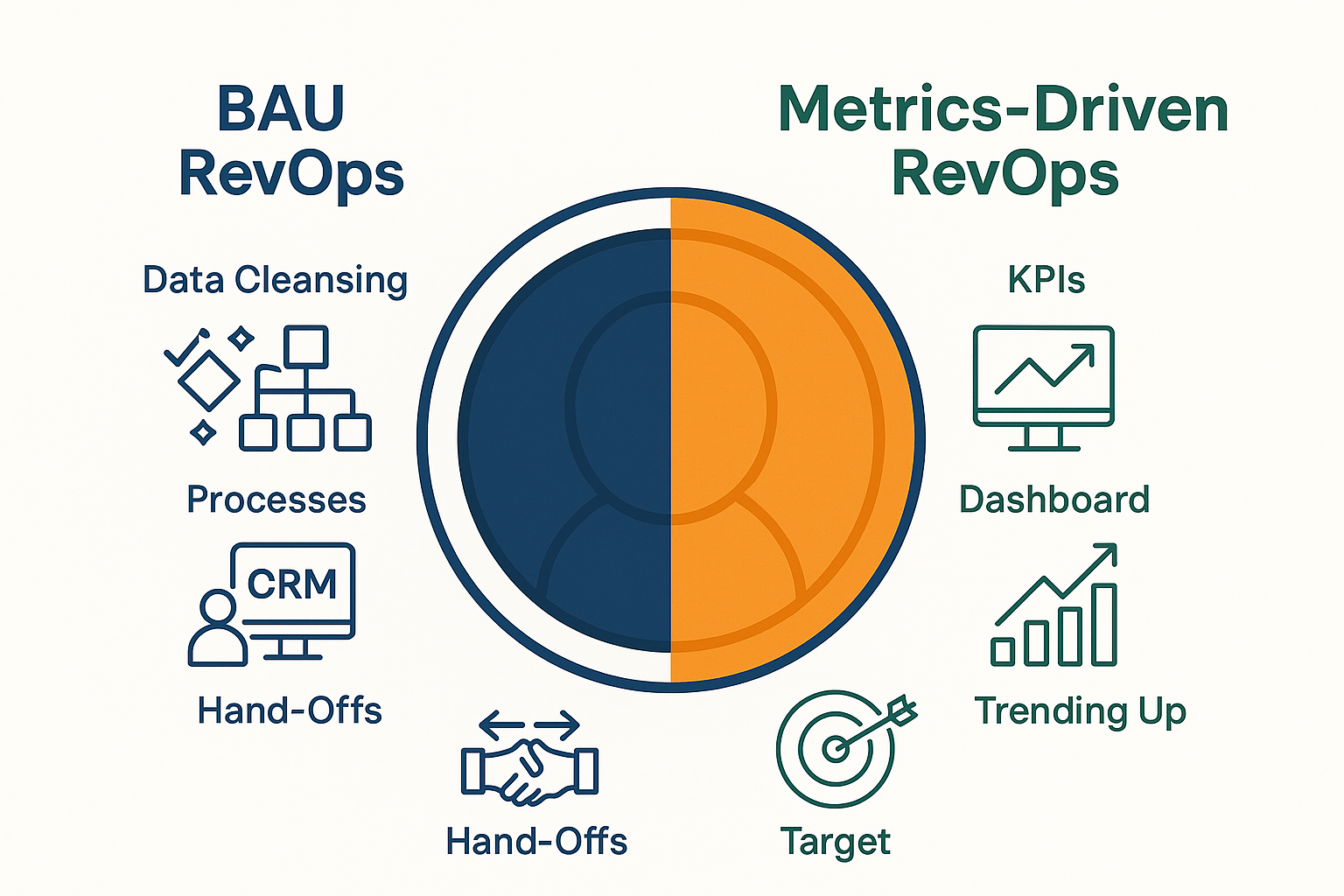Why You Must Define Key Metrics (KPIs) Before Kicking Off a RevOps Project
Picture this: you engage to build out a RevOps engine — new CRM workflows, marketing automation, sales hand-offs, dashboards. Exciting stuff. But as weeks pass, leadership asks the inevitable: “What have we really gained so far?” If you don’t have the answer ready in the form of key metrics or KPIs aligned to business goals, the RevOps initiative can end up somewhere between a cost-centre and a black box.
That’s why before you press “go” you must ask: what are we measuring, why does it matter, and how does it link to the business objectives? Without that foundational clarity, you risk the project becoming an operational refresh rather than a strategic revenue accelerator.

Two Flavours of RevOps: Business-As-Usual vs Metrics-Driven
Business-as-Usual (BAU) RevOps
BAU RevOps is the hygiene work — making sure your revenue engine runs smoothly. It includes things like:
- Cleaning and maintaining CRM data
- Standardising lead-to-opportunity hand-offs
- Ensuring process documentation and hand-off clarity
- Eliminating bottlenecks and tech stack mismatches
- Ensuring that marketing, sales and customer success have consistent definitions, agreed processes, common dashboards
This is critical. If you skip the BAU layer, you’ll have messy data, broken hand-offs, and low user adoption, which all undermine any future metrics-driven work. In short: the foundations must be solid for anything to scale.
Metrics-Driven RevOps
Once BAU is under control, metrics-driven RevOps takes over — where you measure, monitor and optimise against the KPIs that matter for growth. This means:
- Defining your “North Star” metric (e.g., net revenue retention, lifetime customer value, pipeline velocity)
- Establishing leading and lagging indicators (e.g., weighted pipeline value, sales cycle length, CAC, LTV)
- Aligning teams around those metrics so that marketing, sales and success are all contributing to the same outcome
- Building dashboards that shift you from lagging data to predictive insights.
Why It’s The Same Coin
BAU RevOps + Metrics-Driven RevOps = the full RevOps equation. One without the other is flawed. Imagine building a house (BAU) but never measuring how liveable or efficient it is (Metrics). Or trying to optimise and scale (Metrics) without first having a functioning house (BAU). The two must run in parallel — hygiene enabling measurement, and measurement driving improvement.
What Cybersecurity Teams Can Teach RevOps About Metrics Alignment
Elite cybersecurity teams don’t just build firewalls and run audits for the sake of it. They align activities directly to organisational objectives: “protect X% of our customer data by date Y”, “reduce incident response time to under Z hours”, “achieve compliance with ABC control”. Every activity ties back to a business objective and performance is measured accordingly.
RevOps must borrow the same mindset. When RevOps initiatives tie directly to “increase ARR by 20%”, “reduce churn by 15%”, “improve sales cycle by 30%” — then the value becomes tangible. Otherwise, you’ll hear the familiar executive echo: “So what have we paid you all this money for?”
By aligning RevOps activities and KPIs to specific organisational goals you:
- Demonstrate clear ROI of the RevOps investment
- Gain executive buy-in and funding more easily
- Enable continuous improvement (you can see what’s working, what’s not)
- Avoid the trap of RevOps being viewed as a back-office expense
The Perils of Not Aligning RevOps With Specific KPIs
When you skip KPI alignment, you risk:
- Building processes that look good internally but don’t move the needle externally
- Losing stakeholder support because no one can see “so what”
- Siloed metrics that don’t cascade into business outcomes
- Having dashboards full of data but lacking insight — making RevOps feel like a cost, not a value-creator
- A disconnect between teams (marketing, sales, success), each chasing their own targets rather than a unified revenue goal
The Benefits of Aligning to Specific KPIs
Conversely, when you do this properly:
- RevOps becomes a strategic partner, not just an operational function
- You build a measurable revenue engine: you know where you are, where you’re going, and how to get there
- Cross-functional alignment improves — teams give up local vanity metrics and pull on the same rope
- You unlock predictability: forecast accuracy improves, pipelines become healthier, churn reduces, LTV increases
- You are able to show continuous improvement and justify investment in RevOps talent, tech and process
Bringing It All Together
So when you embark on a RevOps project:
- Start with BAU RevOps — build hygiene, standardise processes, ensure data quality, and make sure every hand-off works.
- Define clear Metrics-Driven RevOps — choose KPIs that align with your organisational goals, set targets, build dashboards, and align your GTM teams around those metrics.
- Ensure both run in tandem — you’re keeping the engine clean and measuring how fast it’s going, how efficient it is, and where the leakages are.
- Borrow from the world of cybersecurity — attach everything you do to specific business objectives so the value is obvious, measurable and justifiable.
- Avoid the perils of misalignment and instead reap the benefits of alignment: clarity, predictability, growth, and ROI.
Ready to Drive Revenue?
If you’re about to start a RevOps project and want to ensure you’re doing it the right way — with hygiene, metrics and alignment — talk to us. We help ambitious organisations design and implement RevOps functions that deliver measurable results, not just dashboards. Contact us today for a complimentary consultation, and let’s align your RevOps to the revenue goals that matter.
